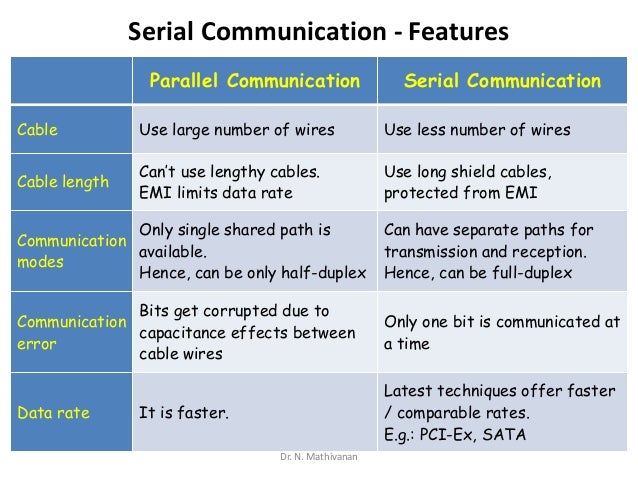
Advantages Of Serial Communication Over Parallel Communication
Serial port communication, which uses Serial ports, was once a popular method of transmitting data. In Serial communication, at a time through a serial port, over a single communication line. If you look on the back side of older computers, you may notice a D-shaped male connector with 9 or 25 pins. Well, if you can find that, then you are actually looking at a serial port. Serial ports also known as COM (communications) ports were extensively used earlier. Serial communication was popular because most computers had one or more serial ports.
All you needed was a cable to connect the instrument to the computer or two computers together. If you are not familiar with computer hardware terms such as ports, input output devices, modem, and so on then will give you ample knowledge on computer parts and terms.
Parallel transmission requires a separate channel for each bit to be transmitted. Serial transmission is much more common, particularly over longer distances.
Serial ports have been around for decades, followed by Parallel ports for transmitting data between a computer and a peripheral or serial device such as a mouse, modem, a programmable instrument, or between two computers. But with the introduction of USB, FireWire, and other faster solutions in recent times, it’s more likely that both serial and parallel ports will be soon completely replaced by the USB ports. Serial Port Details The phrase “serial” implies that a serial port “serializes” data, which means it takes a byte of data and transmits serially each of the 8 bits of a byte one at a time.
This is in contrast to a Parallel Port where all the 8 bits of a byte are transmitted in parallel, all at one time, over a cable with 8 wires. So a serial port needs only one wire to transmit the 8 bits. Serial port communication is useful when data transfer rates are low. Compared to a parallel port, the disadvantage of Serial port is that it takes 8 times longer to transmit the data, but the advantage is that cables used with a Serial port are cheaper and narrower. Serial ports are bi-directional. Bi-directional communication allows each device to receive data as well as transmit it.
Serial devices use different pins to receive and transmit data. So this makes a serial port suitable for full-duplex communication, in which information can travel in both directions at once. Joe haldemanthe forever warreupload epub mobi files.
Before starting transmission of each byte of data, a serial port sends a start bit, which is a single bit with a value of 0. After a byte of data is transmitted, it sends a stop bit to signal that the byte transmission is complete. Pin Information of a Serial Port DB9 connector is a typical Serial Port and below is a description of the signal and signal name against each pin of the connector. Pin 1 is the one on the top left and pin 9 is in the bottom right. PIN SIGNAL NAME DESCRIPTION 1 Carrier Detect DCD Determines if the modem is connected to a working phone line.
2 Receive Data RxData Computer receives information sent from the modem. 3 Transmit Data TxData Computer sends information to the modem. 4 Data Terminal Ready DTR Computer tells modem that it is ready to talk. 5 Signal Ground Gnd Pin is grounded 6 Data Set Ready DSR Modem tells the computer that data is ready 7 Request To Send RTS Computer asks the modem if it can send information 8 Clear To Send CTS Modem tells the computer that it can send information 9 Ring Indicator RI Signal from computer acknowledging that a ring is detected Applications of a Serial Port Here are some of the hardware components that can be used with a serial port: • Mouse – One of the most commonly used device used with serial ports, and specially used with computers that has no PS/2 or USB ports. • Modem – Another commonly used device with serial ports. It was commonly used with older computers. • Network – This was one of the original uses of a serial port, which allowed two computers to be connected for transfer of large files between them.